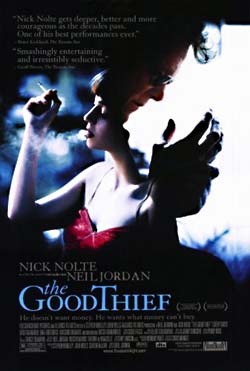 Neil Jordan expends an awful lot of energy in The Good Thief, his remake of Jean-Pierre Melville’s peculiar gangster classic Bob le Flambeur, musing on the nature of duplication and forgery. This is a bit odd because Jordan’s film doesn’t resemble Melville’s unforgettable 1955 achievement very much.
Neil Jordan expends an awful lot of energy in The Good Thief, his remake of Jean-Pierre Melville’s peculiar gangster classic Bob le Flambeur, musing on the nature of duplication and forgery. This is a bit odd because Jordan’s film doesn’t resemble Melville’s unforgettable 1955 achievement very much.
While Jordan has hewed to the plot’s general outlines and to some of the specifics, neither Melville’s nor his movie is plot-driven. Though the line-up of characters has been nominally reproduced, their personalities have been changed so thoroughly as to be otherwise be nearly unrecognizable. Finally, along with reconfiguring significant elements of the action’s central heist and the surrounding complications, Jordan has also reset the action from Melville’s Paris and Deauville to Nice and Monte Carlo.
So what’s come over Jordan? Perhaps it’s just the décor. Perhaps more than any other English-language director, Neil Jordan is the most likely to make intelligent use of décor – and doctored landscape – in expressing the psychological conditions of his characters. When he’s at his best – in The Butcher Boy, for example – you have an intellectually shifting and emotionally moving dynamic even at moments when action appears still and characters mute. At his nadir, which would have to be Interview with a Vampire, he merely burlesques himself.
There’s no burlesque in The Good Thief, but for all Jordan’s huffing and puffing about counterfeiting, there’s not much more either (and certainly nothing approaching Welles’s F for Fake, if that was his intention).
Nick Nolte, wearing his battered face with movie star care, plays Bob Montagnet, an American once prized for his thieving and gambling skills, but now a stone junkie reduced to cheap games by the Mediterranean docks. Jordan introduces us to him with some beautifully shot and choreographed moves in a luscious dive, where Bob gambles, shoots up, saves the life of a cop friend, Roger (Tchéky Karyo), and meets a drop-dead gorgeous 16-year-old hooker from Bosnia, Anne (Nutsa Kukhianidze).
Roger has his eye on Bob because for one thing, he’s sure the old crook must have some job on the back burner and, for another, he’s sure he’ll get caught and end up spending the rest of his life in prison. Roger would like to prevent both things from happening. Unknown to Roger, Bob had no such plans until meeting an old gangster buddy with the inside dope on a Monte Carlo casino, its fabulous art work, and its storehouse. With the help of Anne, Bob quits his habit and gets down to work.
Without getting into details, suffice it to say that nearly every person, and a lot of the loot, isn’t what it pretends to be. Rather than play this as a sinister or even suspenseful gambit, though, Jordan uses it to lighten the material, even when people die. Jordan will always turn to fairy tales when given the chance, and the contrasting settings of smoky junk-and-poker parlors and the Provencal countryside present the material with parallel worlds of foreboding dark forest and happy glen.
Jordan and his frequent cinematographer Chris Menges go even further, shooting the picture in an electrified Fujicolor that propels the action even further into the ether. It also strongly recalls the work of director Wong Kar-Wai and cinematographer Chris Doyle. Whether Jordan just likes their work and is influenced by it, or is just trying to add another layer of duplication to the two or three or 10 he’s already implanted is difficult to say.
Having set a very rich-looking table, Jordan has trouble figuring out who to seat at it. With an actor like Nolte or a beauty such as Kukhianidze, he doesn’t have to worry so much. It’s a good part for Nolte and he pulls the audience through Bob’s changes almost effortlessly; and Kukhianidze is a definite presence. And, with Karyo and one or two of the other supporting actors, Jordan has served himself well. But too many of the other characters would simply fade into the background if the director hadn’t turned them into grotesques. Director Emir Kusturica delivers a scene-destroying turn as an electronics wizard; the filmmaking Polish brothers turn up looking like runaways from the Diane Arbus Home for Unwanted Photo Subjects. Jordan even gives us a bodybuilder with boobs, not because it means anything but, because it’s more memorable than a bodybuilder without boobs.
They say when you marry someone, you marry his or her family, too. Well, when you decide to take on a filmmaker’s virtues, you take on his faults, I guess. Jordan isn’t always arch (see The Butcher Boy again), but he’s arch and awful, awful lot and he’s arch in The Good Thief. But, you know, it’s like marriage.
